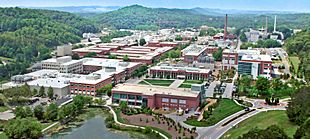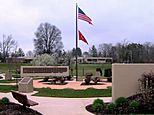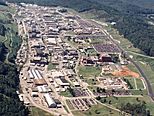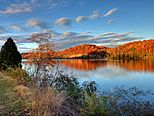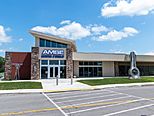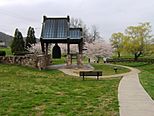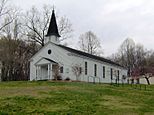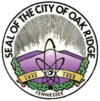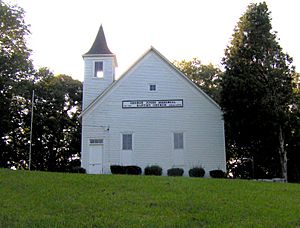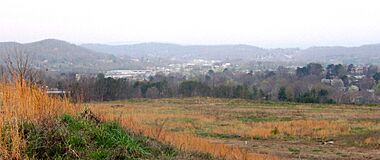Oak Ridge, Tennessee facts for kids
Quick facts for kids
Oak Ridge, Tennessee
|
|||||
|---|---|---|---|---|---|
|
Images, from top down, left to right: Oak Ridge National Laboratory, Commemorative Walk monument, Y-12 National Security Complex, Melton Hill Lake, American Museum of Science and Energy, International Friendship Bell, The Chapel on the Hill
|
|||||
|
|||||
| Nickname(s):
The Atomic City,
The Secret City, The City Behind a Fence |
|||||
| Motto(s):
"The Vision Lives On"
|
|||||

Location of Oak Ridge in Anderson and Roane Counties, Tennessee.
|
|||||
| Country | United States | ||||
| State | Tennessee | ||||
| Counties | Anderson, Roane | ||||
| Established | 1942 | ||||
| Incorporated | 1959 | ||||
| Government | |||||
| • Type | Council-manager (under home-rule charter) | ||||
| Area | |||||
| • Total | 89.95 sq mi (232.98 km2) | ||||
| • Land | 85.25 sq mi (220.80 km2) | ||||
| • Water | 4.70 sq mi (12.18 km2) | ||||
| Area rank | 134th US | ||||
| Elevation | 850 ft (260 m) | ||||
| Population
(2020)
|
|||||
| • Total | 31,402 | ||||
| • Density | 368.35/sq mi (142.22/km2) | ||||
| Time zone | UTC−5 (EST) | ||||
| • Summer (DST) | UTC−4 (EDT) | ||||
| ZIP codes |
37830-37831
|
||||
| Area code(s) | 865 | ||||
| FIPS code | 47-55120 | ||||
Oak Ridge is a city in Tennessee, located in Anderson and Roane counties. It's about 25 miles (40 km) west of Knoxville. In 2020, about 31,402 people lived there. Oak Ridge is known by several cool nicknames, like the Atomic City, the Secret City, and the City Behind a Fence.
In 1942, the U.S. government bought a huge amount of land here. They built a special city for 75,000 people. This city was created to support the Manhattan Project. This was a massive secret operation by America, Britain, and Canada to develop the atomic bomb during World War II. Today, Oak Ridge is still a hub for science and technology. It's home to the Oak Ridge National Laboratory and Y-12 National Security Complex. In 2016, a new element, tennessine, was named after Tennessee. This honored the state's important role in its discovery, especially places like Oak Ridge.
Contents
Discovering Oak Ridge's Past
People have lived in the Oak Ridge area for a very long time. Early signs of people date back to the Woodland period (around 1000 BC to 1000 AD). Scientists found old burial mounds from this time in the 1930s. Before European settlers arrived, the Cherokee people used this land for hunting.
In the early 1800s, several small farming communities grew here. These included places like Edgemoor, Elza, and Wheat. Settlers came after the American Revolutionary War. They arrived after the Cherokee signed a treaty, giving this land to the United States.
There's a famous local story about a man named John Hendrix (1865-1915). People say he predicted the city of Oak Ridge about 40 years before it was built. John was a simple logger with no formal education. After his youngest daughter died, he started hearing voices. These voices told him to pray in the woods for 40 days. After this, he began seeing visions of the future.
He often described a vision of a city with large buildings and factories. He said they would help win "the greatest war that ever will be." He also saw a city on Black Oak Ridge. He described "thousands of people running to and fro" and "great noise and confusion." Many people thought he was not well because of these stories. His grave is now in a part of Oak Ridge called the Hendrix Creek Subdivision. People are working to protect his gravesite.
The Secret Manhattan Project
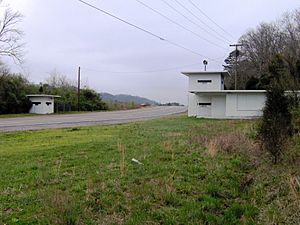
In 1942, the U.S. government picked this area for the Manhattan Project. This was a top-secret effort to create the atomic bomb. Major General Leslie Groves, who led the project, liked the area for many reasons:
- It didn't have many people, so buying the land was easier and cheaper.
- It was easy to reach by roads and trains.
- It had good access to water and electricity from the nearby Norris Dam.
- The area had long valleys separated by ridges. This natural layout offered protection. If something went wrong at one of the plants, it wouldn't easily spread to others.
In October 1942, the United States Army Corps of Engineers started buying over 60,000 acres (24,000 ha) of land. Because the project was so urgent and secret, the government took the land very quickly. Many families found eviction notices on their doors. Some children learned about it from their school principals. They were simply told, "The government is going to take your property for the war effort." No one explained why.

By March 1943, the old communities were gone. Fences and checkpoints were put up around the area. Anderson County lost a lot of its land and tax money. The way the land was taken caused some tension with nearby towns. Even coffins in existing cemeteries were reportedly opened for inspection.
Three main plants were built in Oak Ridge:
- K-25
- S-50
- Y-12
These plants worked to separate uranium-235 from natural uranium. This special uranium was needed for the atomic bomb. During construction, there wasn't enough copper. So, the government borrowed 14,700 tons of silver bullion from the U.S. Treasury to use instead of copper wires! The X-10 site, now Oak Ridge National Laboratory, was built to produce plutonium.
The governor of Tennessee, Prentice Cooper, was not happy about the federal government taking control. He even tore up the official paper making Oak Ridge a military district. But eventually, he visited the project and understood its importance.
Building a Planned Community
The secret nature of the project and the huge number of workers meant Oak Ridge needed a town built quickly. The Army decided to build a more permanent town instead of just a temporary camp. The name "Oak Ridge" was chosen in 1943. It came from ideas given by project workers. The name sounded rural, which helped keep the project a secret.
The company Skidmore, Owings & Merrill designed the town and its houses. John O. Merrill moved to Tennessee to lead the design of these secret buildings. He oversaw the creation of a town that soon had:
- 300 miles (480 km) of roads
- 55 miles (89 km) of railroad tracks
- Ten schools
- Seven theaters
- 17 restaurants
- 13 supermarkets
The new city also had a library, a symphony orchestra, sports facilities, and churches. No airport was built for security reasons. Homes, apartments, and dorms were built very fast. Many were made from special panels called "cemesto." The streets were planned out carefully.
The main roads ran east-to-west, like Oak Ridge Turnpike. North-to-south roads were called "avenues." Smaller streets branching off were "roads," "places," "lanes," or "circles." Avenues were often named alphabetically from east to west. Smaller streets started with the same letter as their main avenue.
Because so many people moved there so fast, there were always shortages of housing and supplies. A company called Roane-Anderson Company managed the town. All workers had to wear special badges. The town was surrounded by guard towers and a fence with seven gates.
Ending Segregation in Oak Ridge
When Oak Ridge was built, it was a segregated community. This was required by some politicians in Congress to get funding for the project. Black workers often had lower-paying jobs. They lived in simple "hutments" (one-room shacks) near the Y-12 plant. These were in the only area set aside for Black residents. Plans for better housing for Black families were made during the war but not built due to lack of resources. After the war, the hutments were removed. A neighborhood of permanent houses for Black families was built in the Gamble Valley area.
Before 1954, schools in Oak Ridge were segregated. Black children could only go to Scarboro Elementary School. Oak Ridge High School was only for white students. Black high school students had to take a bus to Knoxville. In 1950, Scarboro High School was created for African-American students.
In 1955, a big change happened. 85 young Black students from Scarboro were the first to attend the all-white Oak Ridge High School and Robertsville Junior High School. In 2023, a monument was built in Oak Ridge to honor these "Scarboro 85" students. Other elementary schools and Jefferson Junior High School slowly became integrated as Black families moved into other parts of the city. In 1967, Scarboro Elementary School closed. Black students from Gamble Valley were then bused to other schools.
The nearby high school in Clinton was also desegregated in 1956. It was bombed in 1958 and closed for rebuilding. Oak Ridge helped out by providing a school building for Clinton students for two years.
Public places in Oak Ridge also slowly became integrated after the Brown court decision. In 1955, the Oak Ridge Municipal Outdoor Swimming Pool became integrated. In the early 1960s, there were some protests against segregation in places like cafeterias and laundromats.
Oak Ridge After World War II
Two years after World War II, Oak Ridge was no longer under military control. It was managed by the United States Atomic Energy Commission. In 1959, the town officially became a city. It adopted a city manager and City Council government.
Two of the four main facilities built for the war are still standing:
- Y-12: Once used to separate uranium, it now handles nuclear weapons materials.
- X-10: This was a test reactor site. It is now the Oak Ridge National Laboratory (ORNL).
The United States Department of Energy (DOE) runs ORNL. It's a major research center for nuclear and high-tech science. In 2018, IBM and ORNL showed off Summit. It was the "world's fastest supercomputer" at the time. It could do 200,000 trillion calculations per second!
You can learn about Oak Ridge's science history at the American Museum of Science and Energy. Its role in the Manhattan Project is part of the Manhattan Project National Historical Park. You can even take bus tours to see some of the historic sites.
Growing the Economy
In 2003, Oak Ridge expanded its city limits to include a new community. This helped the city grow its economy. In 2020, the city council approved a plan to build a new downtown area. This plan includes shops, homes, and restaurants.
Where is Oak Ridge?
Oak Ridge is located in a unique area. The Clinch River flows around it, creating a half-rectangle shape. This means water borders the city on the northeast, east, and southwest.
The area has five long ridges that run parallel to each other. From west to east, they are Blackoak Ridge, East Fork Ridge, Pine Ridge, Chestnut Ridge, and Haw Ridge. These ridges are separated by four valleys: East Fork Valley, Gamble Valley, Bear Creek Valley, and Bethel Valley. These ridges and valleys are part of the Ridge-and-Valley Appalachians. The main part of the city is in the northeast, where the ridges become lower hills. Many homes are built on the slopes of Blackoak Ridge.
The Melton Hill Dam was completed in 1963. This created Melton Hill Lake, which is on the northeast and east sides of the city. The lake is a popular place for fun, with bike trails and picnic areas. It's also famous for rowing competitions. Watts Bar Lake also borders Oak Ridge to the south and southwest.
Oak Ridge covers about 90.0 square miles (233.0 km2). About 85.3 square miles (220.8 km2) is land, and 4.7 square miles (12.2 km2) is water. The highest point is Melton Hill, which is about 1,356 feet (413 m) high.
Oak Ridge's Weather
Oak Ridge has a humid subtropical climate. This means it has hot, humid summers and mild winters. The average temperature in January is about 37.9 °F (3.3 °C). In July, it's around 77.5 °F (25.3 °C). On average, the temperature stays at or below freezing for about 4.3 days a year. It gets to 90 °F (32 °C) or higher about 39 days a year.
The lowest temperature ever recorded was −17 °F (−27 °C) on January 21, 1985. The highest was 105 °F (41 °C) on June 30, 2012, and July 28, 1952. But temperatures of 0 °F (−18 °C) or 100 °F (38 °C) are not common.
Oak Ridge gets about 59.70 inches (1,516 mm) of rain each year. The driest time is usually late summer. The most rain in one day was 7.45 inches (189 mm) on August 10, 1960.
| Climate data for Oak Ridge (Atmospheric Turbulence & Diffusion Division), Tennessee (1991–2020 normals, extremes 1947–present) | |||||||||||||
|---|---|---|---|---|---|---|---|---|---|---|---|---|---|
| Month | Jan | Feb | Mar | Apr | May | Jun | Jul | Aug | Sep | Oct | Nov | Dec | Year |
| Record high °F (°C) | 76 (24) |
82 (28) |
86 (30) |
92 (33) |
96 (36) |
105 (41) |
105 (41) |
103 (39) |
102 (39) |
98 (37) |
85 (29) |
78 (26) |
105 (41) |
| Mean maximum °F (°C) | 67.3 (19.6) |
71.2 (21.8) |
79.4 (26.3) |
86.0 (30.0) |
89.6 (32.0) |
93.8 (34.3) |
96.0 (35.6) |
94.8 (34.9) |
92.5 (33.6) |
84.6 (29.2) |
75.3 (24.1) |
67.4 (19.7) |
96.8 (36.0) |
| Mean daily maximum °F (°C) | 46.6 (8.1) |
51.4 (10.8) |
60.7 (15.9) |
70.4 (21.3) |
77.7 (25.4) |
84.0 (28.9) |
87.0 (30.6) |
86.6 (30.3) |
81.0 (27.2) |
71.0 (21.7) |
58.9 (14.9) |
49.3 (9.6) |
68.7 (20.4) |
| Daily mean °F (°C) | 37.9 (3.3) |
41.7 (5.4) |
49.7 (9.8) |
58.6 (14.8) |
66.9 (19.4) |
74.1 (23.4) |
77.5 (25.3) |
76.8 (24.9) |
70.8 (21.6) |
59.7 (15.4) |
48.1 (8.9) |
40.9 (4.9) |
58.6 (14.8) |
| Mean daily minimum °F (°C) | 29.2 (−1.6) |
32.1 (0.1) |
38.7 (3.7) |
46.8 (8.2) |
56.1 (13.4) |
64.1 (17.8) |
68.1 (20.1) |
67.0 (19.4) |
60.6 (15.9) |
48.4 (9.1) |
37.3 (2.9) |
32.4 (0.2) |
48.4 (9.1) |
| Mean minimum °F (°C) | 11.3 (−11.5) |
16.2 (−8.8) |
22.4 (−5.3) |
31.5 (−0.3) |
41.0 (5.0) |
53.7 (12.1) |
60.4 (15.8) |
59.3 (15.2) |
47.4 (8.6) |
33.2 (0.7) |
23.8 (−4.6) |
17.7 (−7.9) |
8.7 (−12.9) |
| Record low °F (°C) | −17 (−27) |
−13 (−25) |
1 (−17) |
20 (−7) |
30 (−1) |
39 (4) |
49 (9) |
50 (10) |
33 (1) |
21 (−6) |
0 (−18) |
−7 (−22) |
−17 (−27) |
| Average precipitation inches (mm) | 5.50 (140) |
5.93 (151) |
5.55 (141) |
5.58 (142) |
4.50 (114) |
4.76 (121) |
5.90 (150) |
3.72 (94) |
4.13 (105) |
3.29 (84) |
5.00 (127) |
5.84 (148) |
59.70 (1,516) |
| Average snowfall inches (cm) | 1.8 (4.6) |
1.4 (3.6) |
0.6 (1.5) |
0.0 (0.0) |
0.0 (0.0) |
0.0 (0.0) |
0.0 (0.0) |
0.0 (0.0) |
0.0 (0.0) |
0.0 (0.0) |
0.0 (0.0) |
0.6 (1.5) |
4.4 (11) |
| Average precipitation days (≥ 0.01 in) | 11.9 | 11.7 | 12.3 | 11.0 | 12.0 | 12.3 | 12.5 | 10.0 | 8.2 | 8.4 | 9.2 | 12.2 | 131.7 |
| Average snowy days (≥ 0.1 in) | 1.2 | 1.1 | 0.4 | 0.0 | 0.0 | 0.0 | 0.0 | 0.0 | 0.0 | 0.0 | 0.0 | 0.6 | 3.3 |
| Source: NOAA | |||||||||||||
Who Lives in Oak Ridge?
| Historical population | |||
|---|---|---|---|
| Census | Pop. | %± | |
| 1960 | 27,169 | — | |
| 1970 | 28,319 | 4.2% | |
| 1980 | 27,662 | −2.3% | |
| 1990 | 27,310 | −1.3% | |
| 2000 | 27,387 | 0.3% | |
| 2010 | 29,330 | 7.1% | |
| 2020 | 31,402 | 7.1% | |
| 2023 (est.) | 33,397 | 13.9% | |
| Sources: | |||
In 2020, Oak Ridge had 31,402 people. There were 12,008 households and 7,641 families.
2020 Census Details
| Race | Number | Percentage |
|---|---|---|
| White (not Hispanic) | 24,163 | 76.95% |
| Black or African American (not Hispanic) | 2,317 | 7.38% |
| Native American | 84 | 0.27% |
| Asian | 818 | 2.6% |
| Pacific Islander | 47 | 0.15% |
| Other/Mixed | 2,040 | 6.5% |
| Hispanic or Latino | 1,933 | 6.16% |
2010 Census Details
In 2010, there were 29,330 people in Oak Ridge. The city had 12,772 households. About 25.2% of households had children under 18. About 45.2% were married couples. The average household had 2.26 people. The average family had 2.86 people.
The median age was 43.5 years old. About 22.0% of the population was under 18. About 19.3% were 65 or older. The median income for a household was $48,716. For a family, it was $69,333. About 16.0% of the population lived below the poverty line.
Oak Ridge's Economy and Jobs
The federal government projects are still the main source of jobs in Oak Ridge. They are one of the biggest employers in the Knoxville metropolitan area. The United States Department of Energy (DOE) owns these sites.
- Oak Ridge National Laboratory (ORNL) is the largest research lab in the DOE system. It has the Spallation Neutron Source, a huge project finished in 2006. It also has "Titan", one of the world's most powerful supercomputers.
- The Y-12 National Security Complex is part of the U.S. nuclear weapons program. The DOE is working to clean up and remove old hazardous materials from past activities.
Other important organizations include:
- The DOE's Office of Scientific and Technical Information, which shares government research.
- The Oak Ridge Institute for Science and Education (ORISE), which runs research and education programs.
- The Atmospheric Turbulence and Diffusion Division (ATDD), which studies air quality.
The nuclear industry continues to grow in Oak Ridge. Plans include new types of nuclear reactors, nuclear fuel plants, and a nuclear medicine plant.
Some companies have also started in Oak Ridge, like IPIX and ZYP Coatings. Greg LeMond, a famous cyclist, has a carbon fiber business here. Several companies that process radioactive waste also operate in Oak Ridge.
The city's old buildings from the 1940s are getting older. Oak Ridge is now becoming more connected to the Knoxville area. Its past as a "super secret" government site is fading. The economy is changing, too. For example, the Oak Ridge City Center, a shopping mall, was partly torn down and rebuilt.
Learning in Oak Ridge
The city has a preschool, four elementary schools (kindergarten to grade 4), two middle schools (grades 5 to 8), and one high school (grades 9 to 12). The Oak Ridge school district is highly rated in Tennessee. Oak Ridge High School was ranked as a top high school in 2017.
Private schools include the Montessori School of Oak Ridge and St. Mary's School. The Oak Ridge Institute for Continued Learning offers many classes for adults.
Roane State Community College has its largest branch campus in Oak Ridge. Other higher education groups here include the Oak Ridge Institute for Science and Education and Oak Ridge Associated Universities.
News and Entertainment
Oak Ridge has a daily newspaper called The Oak Ridger. It was also home to the AM radio station WATO for many years.
Sports and Fun
Oak Ridge has a great rowing venue on Melton Hill Lake. It hosts big events like the US Rowing Youth Summer National Championship. Oak Ridge has also hosted cycling events.
The city once had a Minor League Baseball team called the Oak Ridge Pioneers in 1954. Another team, the Oak Ridge Bombers, played briefly in 1948.
Famous People from Oak Ridge
Many notable people were born or lived in Oak Ridge:
- Jennifer Azzi, WNBA player and Olympic gold medalist
- General B.B. Bell, retired general
- Lee Clayton, country-rock singer/songwriter
- Dean Dillon, songwriter in the Country Music Hall of Fame
- Charlie Ergen, co-founder of Dish Network
- Megan Fox, actress
- Tee Higgins, NFL player
- Kai-Fu Lee, Google executive
- Randy McNally, Tennessee Lieutenant Governor
- Edgar Meyer, Grammy Award-winning bassist
- Clarice Phelps, nuclear chemist
- William Shepherd, astronaut, commander of the first crew on the International Space Station
- Clifford Shull, Nobel Prize-winning physicist
- Gore Verbinski, film director (Pirates of the Caribbean series)
- Alvin Weinberg, nuclear physicist
- Ed Westcott, the only authorized photographer in Oak Ridge during the Manhattan Project
- Eugene Wigner, Nobel Prize-winning physicist
- Adam Wingard, director
The music group The Oak Ridge Boys got their name from performing often at Oak Ridge National Laboratory early in their career.
Places to Visit
- Alexander Inn (a historic building)
- American Museum of Science and Energy
- Children's Museum of Oak Ridge
- East Tennessee Technology Park
- Manhattan Project National Historical Park
- Oak Ridge National Laboratory
- Office of Scientific and Technical Information
- United Church, The Chapel on the Hill
- University of Tennessee Arboretum
- Y-12 National Security Complex
Sister Cities
Oak Ridge has sister cities around the world:
See also
 In Spanish: Oak Ridge (Tennessee) para niños
In Spanish: Oak Ridge (Tennessee) para niños


